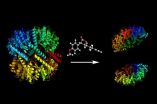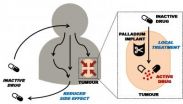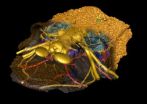(Press-News.org) This news release is available in German.
Researchers at the Helmholtz Center Berlin (HZB) have taken a leap forward towards a deeper
understanding of an undesired effect in thin film solar cells based on amorphous silicon – one
that has puzzled the scientific community for the last 40 years. The researchers were able to
demonstrate that tiny voids within the silicon network are partly responsible for reducing solar
cell efficiency by some 10 to 15 percent as soon as you start using them. Their work has now
been published in Physical Review Letters (DOI: 10.1103/PhysRevLett.112.066403).
Amorphous silicon thin film solar cells are considered a promising alternative to solar cells
based on highly purified silicon wafers, which have been dominating photovoltaic power
generation. A major advantage of amorphous silicon thin film photovoltaics, where a glass
substrate is coated with a light active material less than a thousandth of a millimeter thick,
is that the cell fabrication is considerably simpler and much less costly than in the case of
conventional crystalline silicon solar cells. On the other hand, a potential disadvantage is the
low conversion efficiency from solar energy to electricity. Because of the disordered nature of
amorphous silicon, solar cells are subject to the Staebler-Wronski effect, which reduces the
solar cell efficiency by up to 15 percent within the first 1000 hours.
This undesired
effect is triggered by internal annihilation – known in physics as recombination - of charge
that has not been extracted from the solar cell. The released recombination energy induces
defects in the amorphous network - which is why this effect is not observed in crystalline wafer
solar cells. "However, where defects are produced in the material and whether voids of nanoscale
size play a role in all this has not been understood – until now, that is," says HZB's own
Matthias Fehr of the Institute for Silicon Photovoltaics. Fehr together with his HZB colleagues,
scientists from Jülich Research Center and the Free University of Berlin have now made major
strides towards unraveling this mystery.
Since the defects that form exhibit paramagnetic
properties, they have a characteristic magnetic fingerprint, which depends on their microscopic
environment. The Berlin researchers were able to identify this fingerprint using
electron-paramagnetic resonance (EPR) spectroscopy and electron-spin echo (ESE) experiments.
With the help of these highly sensitive techniques, they determined that defects in amorphous
silicon actually come in two types: those that are uniformly distributed and those that are
concentrated in clusters on internal surfaces of small voids - known in scientific circles as
microvoids - which form within the material during the solar cell manufacturing process. "Our
guess is that clusters of defects are generated on the internal walls of microvoids, which have
a diameter of a mere one to two nanometers," explains HZB physicist Fehr. "Our findings seem to
suggest that microvoids most likely contribute to light-induced degradation of amorphous silicon
thin film solar cells. For us, it's been a leap forward towards a better understanding of the
microscopic mechanism of light-induced degradation," says Fehr who, in 2013, spent a year
conducting research in the US as a Feodor Lynen Scholar of the Alexander Humboldt Foundation. A
new series of experiments has been designed to allow the Berlin researchers to glean further
insights into the atomic and electronic processes of the Staebler-Wronski effect, named for the
two scientists who first discovered it.
The work is part of the EPR-Solar network funded
by the German Federal Ministry for Education and Research and the HZB's and FUB's Berlin Joint
EPR Lab. According to the head of the project, Prof. Dr. Klaus Lips, "this is one of the major
projects of one of the HZB's newest research departments, which is currently in the founding
stage and whose mission is the fundamental physical characterization of energy materials with
the goal of making an important contribution to the energy transition."
INFORMATION:
References: [1]
Fehr, M., Schnegg, A., Rech, B., Astakhov, O., Finger, F., Bittl, R., Teutloff, C., Lips, K.
(2014) Metastable defect formation at microvoids identified as a source of light-induced
degradation in a-Si:H. Phys. Rev. Lett. (accepted)
Light-induced degradation in amorphous silicon thin film solar cells
2014-02-13
ELSE PRESS RELEASES FROM THIS DATE:
Two new weapons in the battle against bacteria
2014-02-13
This news release is available in German.
Proteins are made up of a chain of amino acids and are vital for all cell processes. Proteases are among the most important types of protein. Like "molecular scissors", they cut other proteins at given positions and thereby execute important cell functions. By cutting the amino acid chains to the right length or breaking proteins apart they, for example, activate or deactivate proteins, decompose defective ones or switch signal sequences that serve to transport proteins to their proper position within a cell.
But proteases ...
Metal implants may cut chemotherapy side effects, study suggests
2014-02-13
Cancer patients could one day experience fewer side effects from chemotherapy following a discovery that opens the door for more targeted treatments.
Researchers have identified a possible way of treating tumours that would see doctors place harmless metal implants at the cancer site.
The discovery could make treatment more targeted than existing therapies, avoiding unwanted side effects, such as hair loss, tiredness and nausea. These occur when chemotherapy drugs carried in the blood kill healthy cells as well as cancer cells.
The scientists found that they could ...
Deutsche eMark (DEM) - Could be second cryptocurrency coin after Bitcoin
2014-02-13
Deutsche eMark is an open source peer-to-peer digital Internet currency. Deutsche eMark stands for fast and secure payments to anyone around the world, who has an eMark Wallet. Therefore no banks are required and the fees are low and simple to understand. Today price on Cryptsy Exchange is 0.00012, but experts says, that it could fast reach 0.002 DEM/BTC.
Sleep apnea common among stroke-related brainstem injuries
2014-02-13
People whose brainstems are affected by their stroke have a significantly higher prevalence of sleep apnea than those who have stroke-related injury elsewhere in the brain, according to research presented at the American Stroke Association's International Stroke Conference 2014.
Sleep apnea is marked by interrupted breathing during sleep and can lead to serious health problems including heart disease and stroke.
"This is the largest population-based study to address the issue of the location of the brain injury and its relationship to sleep apnea in post-stroke patients," ...
ADHD drugs not linked to increased stroke risk among children
2014-02-13
Children who take medication to treat attention deficit hyperactivity disorder (ADHD) don't appear to be at increased stroke risk, according to a study presented at the American Stroke Association's International Stroke Conference 2014.
In a study of 2.5 million 2- to 19-year-olds over a 14-year period, researchers compared stimulant medication usage in children diagnosed with ischemic or hemorrhagic stroke to stimulant usage in children without stroke.
Researchers found no association between stroke risk and the use of ADHD stimulant medications at the time of stroke ...
Worm infections in developing countries: Veterinary drugs improve the health of school children
2014-02-13
This news release is available in German.
Hookworms and whipworms are detrimental to health. Children in many developing countries in particular are prone to regular infection via contaminated soil due to a lack of latrines and clean water. Whipworm eggs enter the body via the gastrointestinal tract and evolve over several devel-opment stages. To contain the health risks of worm infections, the WHO recommends annual de-worm treatment for children and at-risk groups (such as field hands and miners). However, the recommended standard treatment appears to have little ...
New research uncovers debilitating effects of disease on toy dog breeds
2014-02-13
A new study from the University of Surrey, published today in the journal PLOS One, has identified the specific effect Chiari malformation has on the shape of a dog's skull and brain. This condition has become prevalent as a result of selective breeding and affects many toy dog breeds which have been bred to look more doll-like, including Griffon Bruxellois, Cavalier King Charles Spaniels, Chihuahuas and their crosses.
Researchers took brain, skull and vertebrae measurements of 155 Griffon Bruxellois and compared dogs affected by the condition, with normal Griffons. ...
Jawed vertebrates get a face
2014-02-13
This week in the leading journal Nature, a team of French and Swedish researchers present new fossil evidence for the origin of one of the most important and emotionally significant parts of our anatomy: the face. They show how a series of fossils, with a 410 million year old armoured fish called Romundina at its centre, documents the step-by-step assembly of the face during the evolutionary transition from jawless to jawed vertebrates.
Vertebrates (backboned animals) come in two basic models: jawless and jawed. Today, the only jawless vertebrates are lampreys and hagfishes, ...
Quality of acupuncture needles is less than perfect and must improve
2014-02-13
The quality of acupuncture needles is high, but should still be universally improved to avoid potential problems, such as pain and skin reactions, finds research published online in Acupuncture in Medicine (AiM).
Despite improvements to the manufacturing process, surface irregularities and bent tips have not been completely eliminated, say the researchers.
In China, traditional Chinese medicine including acupuncture, accounts for 40% of all medical treatment, while in the West, acupuncture is one of the most frequently used complementary therapies.
An estimated 1.4 ...
Tobacco industry claims 'plain' packs won't work based on weak evidence
2014-02-13
Tobacco companies lack strong, relevant evidence to support their claims that standardised (plain) packaging of tobacco products in the UK won't work, finds research published in the online journal BMJ Open.
The aim of plain packaging, with no logos, brand imagery, symbols, or promotional text, is to restrict the already limited opportunities that transnational tobacco companies have to market their products, and deter people from starting smoking.
Australia adopted plain packaging for tobacco products in 2012, the same year that the Department of Health in England ...




